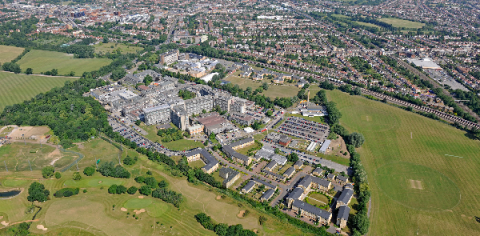This case study highlights how multiple landowners, with strong leadership, an ethos of problem-solving and partnership working, can work well together to deliver a large-scale regeneration scheme despite several potential viability showstoppers.
Introduction
-
This 12.87ha site comprises land previously developed in a piecemeal way over many years. It includes part of the existing Northwick Park hospital and ancillary facilities, Westminster University campus, residential accommodation, surface car parking and some open land for public recreation.
-
The redevelopment proposals aim to use this land for:
-
up to 1,600 new homes (40% affordable)
-
expansion of the University of Westminster Harrow Campus
-
a new access road and associated junction improvements
-
small-scale commercial units and a replacement nursery
-
-
There are four land owners. NHS Trust; Network Homes; Brent Council; and University of Westminster. They formed a partnership under the One Public Estate (OPE) programme.
-
Brent Council has dual roles. It is a key member of the landowner/development partnership; and is the Local Planning Authority (LPA). Brent sought to ensure commercial confidentiality and probity through a transparent planning process.
-
Aerial view of site
Key Success Factors
Planning
-
Continuity of staff. Having people who understand the project context, issues and what is trying to be achieved is crucial. This has resulted in a “great approach” (Applicant’s Agent) to the project by the local authority.
-
Adopting a ‘layered approach’ to gaining planning permission. Partners were all operating to different timeframes. Submitting outline and full applications simultaneously kept momentum and created a “very much a win-win situation” (Applicant’s Agent).
-
Securing transport provision contributions. The LPA was pivotal in ensuring that the development secured necessary contributions towards public transport infrastructure.
-
Allocating the site in the Local Plan. Brent Council allocated the site in successive local plans.
Key Planning Tools
-
A master planning exercise for the site was undertaken in 2017. This established the general regeneration principles and formed the starting point for cooperation between the LPA and stakeholders.
-
A ‘layered’ approach to gaining planning permission. Outline permission for the whole site was sought in tandem with separate full permissions for parts of the site. Each has its own Section 106 agreement.
-
Design Codes. The planning applications have a Design Code (created in February 2020). This informs the detailed design considerations and demonstrates an aspiration for high quality and carefully considered design.
Site Identification
-
Adopted Local Plan (2022). The site is allocated in successive local plans by Brent Council. It now forms part of the adopted Local Plan (2022) as a ‘growth area’.
Site Viability
-
The partners’ different timescales for key stages. The four partners work to differing timescales. Each have their own commitments and need information and certainty at different times. This has to be managed through careful communications.
-
Site access - Housing Infrastructure Funding (HIF) helped pay for the ‘ring/spine road’. This was fundamental to unlocking the site’s redevelopment.
-
Balancing competing requirements. The development of the site included balancing different requirements:
-
Affordable housing
-
Public transport system enhancements
-
Achieving a reduction in carbon emissions.
-
-
Decisions on Community Facilities. A new location had to be found for a community pavilion.
Leadership & Governance
-
Strong leadership. A positive, forward-looking approach to delivering the scheme’s objectives was provided by Brent Council. The council took the lead through the OPE programme, creating a shared vision and coordinating the development activities.
-
A Memorandum of Understanding was created to facilitate and set out the parameters for collaborative working.
Key Lessons Learned
-
Regular, frank and open communication between the local authority and external partners and consultees is critical to timely delivery. Partners and consultees appreciated receiving clear, honest and transparent advice from officers and the frequent and high-quality discussions with LPA officers.
-
Goodwill, hard work, professionalism and perseverance is required to overcome frustrations. “Officers are constantly looking for solutions, but not slow to say that what doesn't work or this could do with improvement and by them coming off the fence quite quickly. It allowed us [the applicant] to respond quite quickly too” (Applicant’s Agent). “Be frank and open minded, that's the important thing. I liked the fact that Brent were willing to commit to providing candid advice” (Applicant’s Agent).
-
Consider a range of options for gaining permission. Being open and willing to look at a range of options for gaining planning permission is important. Avoid assuming that the traditional approaches are best. In this instance adopting the unusual ‘layered approach’ to gaining planning permission was critical to its success.
-
Site viability is constantly changing due to both on-site amendments and external conditions. Dealing with viability issues is challenging. Adopting round table discussions within a fixed timescale and beginning earlier in the process providse a more focused approach to completing negotiations.
-
Combining land parcels. The OPE partnership working approach illustrates how larger sites with different landowners can be successfully assembled to deliver wider public/community benefit. “It definitely makes the case for land agglomeration across strategic locations… where everyone's on board with the same vision” (Applicant’s Agent).
-
Design infrastructure around available funding early; don't leave it to the last minute. A strategic policy approach complementing the standing advice from Transport for London could have sped up negotiations. Issues could have been flagged-up and dealt with earlier. It will help to “cost your mitigation early doors, design your infrastructure for the amount of money you have. Don't leave it to the last minute” (TfL).
-
Quality of design is important. Having a scheme that those working on it, and the communities hosting it, can be proud of.
-
Create an internal ‘working party’. This avoids silo working. The working party should represent the various departments within the council. The Chair should be able to coordinate approaches/objectives across the authority.
Full Detailed Case Study
LB Brent Northwick park Hospital Site

